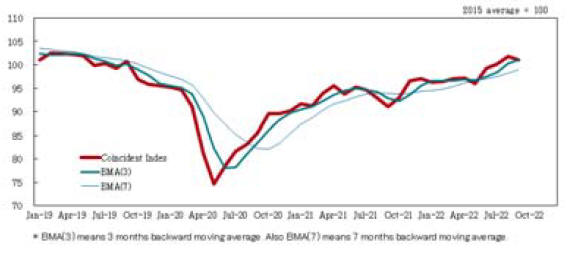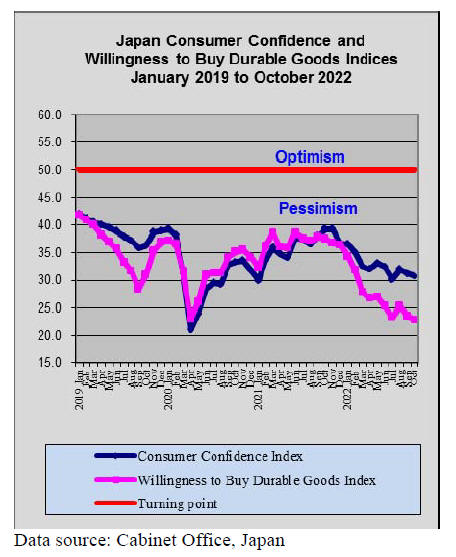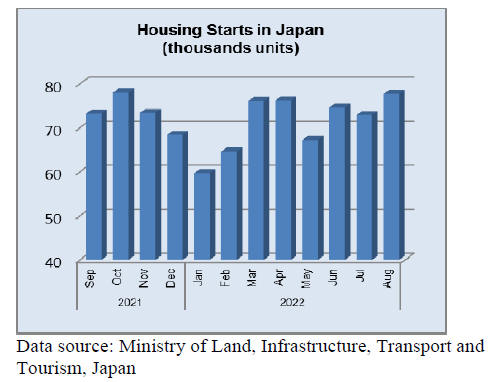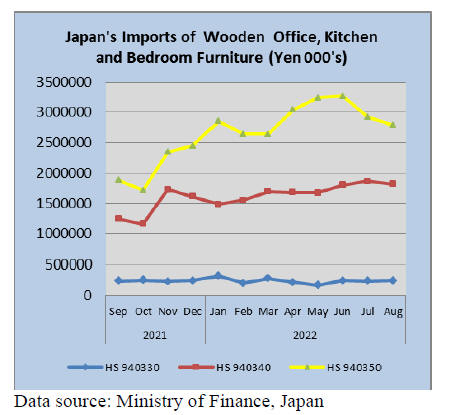Japan
Wood Products Prices
Dollar Exchange Rates of 10th
Nov
2022
Japan Yen 138.80
Reports From Japan
Trying to beat
global market forces
The Japanese authorities had spent over US$40 billion on
currency intervention up to the end of October, one of the
largest amounts in 30 years in an effort to support the yen
in currency markets.
To address the impact of inflation the government
announced a massive stimulus package but the Bank of
Japan is pinning all its hopes on companies raising wages
to drive what is called good inflation (as opposed to the
current imported inflation) and a slowdown in interest rate
increases in the US. Many economists, however, are
skeptical that the package will effectively boost the
economy.
See:
https://www.asahi.com/ajw/articles/14757593
and
https://www.ft.com/content/f9aca1c2-50c6-4040-8322-6ddfacda6cd6
Sentiment among manufacturers at new low
Sentiment among Japanese manufacturers dropped to a
new low in early November but in the services sector the
mood improved. This, according to analysts of the recent
Reuters poll, highlights the unevenness of Japan's
economic recovery.

Inflation set to dampen household spending
The Ministry of Internal Affairs and Communications has
reported Japan's household spending in September
increased from a year earlier, rising for the fourth month in
a row as people spent more money following the removal
of coronavirus restrictions.
The question is whether the improvement in household
spending will be sustained given that inflation rose to 3%
in September, the first time in over 30 years and this will
dampen spending. At the same time, real wages fell 1.3%
from a year earlier in September marking the sixth
consecutive month they dropped.
Falling real wages may herald a further cooling of
consumer sentiment in the coming months and a bleak
outlook for consumption which accounts for more than
half of Japan's gross domestic product.
See:
https://mainichi.jp/english/articles/20221108/p2g/00m/0bu/003000c
and
https://www.marketpulse.com/20221108/yen-yawns-ashousehold-spending-rises/
Stagnant wage growth plus inflation a toxic mix
Over the past 30 years global average wages have risen,
the exception being Japan, where wages have remained
relatively flat. Minimum hourly wages in most European
countries range from 1,500 to almost 2,300 yen while in
Japan they are below 1,000 yen in most cases.
With the rapidly depreciated yen exchange rate the
purchasing power of 1,000 yen has fallen over 20% in the
past month.
See:
https://unseenjapan.com/working-in-japan-weak-yen/

Lower pace of US inflation lifts yen
Japan appears to be facing an extended period of low
growth and a weak yen as the U.S. Federal Reserve
continues its aggressive monetary tightening amid soaring
inflation.
The yen rose against the dollar mid November after US
inflation data showed a decline in the pace of increase.
The US Consumer Price Index rose by 7.7% in October
compared to a year earlier, the first time in eight months
that the figure was below 8%.

When interst rates rise home loan burden will
jump
The outstanding value of home loans continues to rise and
at the end of June stood at around US$1.5 trillion. In
contrast asset value of houses remains stagnant. Most
borrowers in Japan opt for variable-rate mortgages. A rise
of 0.1% in loan rates would increase the cumulative
outstanding interest by about 110 billion yen.

Import update
Furniture imports
August import values were steady and with the yen
exchange rate at around 135 to the US dollar there was
little impact on imports. In the final quarter of the year the
sharp depreciation of the yen against all major currencies
pushed up the cost of imports and this is likely to be
reflected in the trend of wooden furniture imports.
The value of August imports of HS 940330 from China
were up slightly on July as was the value of imports from
both Vietnam and Poland. Year on year, August 2022
wooden furniture imports were down by 23% marking two
straight months of decline. When compared to the value of
July imports there was little change in August.

August office furniture imports (HS 940330)
Over 85% of Japan’s imports of wooden office furniture
(HS940330) in August originated in China. A further 4%
of the value of wooden office furniture came from each of
Vietnam and Poland. The only other significant shipper in
August was Indonesia.

August kitchen furniture imports (HS 940340)
The Philippines and Vietnam each accounted for over 35%
of Japan’s August imports of wooden kitchen furniture
(HS 940340). The other main shippers in August were
China and Italy, each accounting for a further 5% of the
value of imports. Compared to a month earlier the value of
imports from all the main suppliers was almost the same
as in July.
After two consecutive monthly increases the total value of
HS 940340 imports there was a correction in August when
a 12% drop against the value of July imports was reported.
However, year on year August 2022 imports were up 35%.

August bedroom furniture imports (HS 940350)
The downward correction in the value of imports of
wooden bedroom furniture (HS 940350) reported for July
extended into August when there was a further 5%
decline. Year on year the value of August 2022 imports
were up 30%.
Most of the imports of wooden bedroom furniture during
the year were from China which, in August 61% of the
value of imports followed by Vietnam at 30% and just 3%
from Malaysia which saw an increase in the value of
shipments in August.
The other shippers of note in August were Indonesia and
Poland both of which saw advances. On the other hand, a
significant shipper in July, Thailand, saw a sharp drop in
August shipments.

Trade news from the Japan Lumber Reports (JLR)
The Japan Lumber Reports (JLR), a subscription trade
journal published every two weeks in English, is
generously allowing the ITTO Tropical Timber Market
Report to reproduce news on the Japanese market
precisely as it appears in the JLR.
For the JLR report please see:
https://jfpj.jp/japan_lumber_reports/
Block by FSC
The FSC (Forest Stewardship Council) released
information about removal of An Viet Phat Energy Co.,
Ltd., which is a major wooden pellet manufacturing
company in Vietnam, from the FSC member.
The reason is that the company had mendacious labeling
on purpose. CoC (Chain of Custody) of the company is
cancelled and the company is not able to reapply for the
certification for next three and a half years. In recent
years, volume of pellet from Vietnam has been increasing
in Japan and some of pellet would be from An Viet Phat
Energy.
According to the FSC, the company foisted off raw materials
as certified and sold the produces as FSC products to the
clients. There were forged documents used. There was an
investigation to the company, which sells raw materials, and
there was no fact about cutting down trees at authorized
forest by the FSC and selling authorized raw materials to An
Viet Phat Energy. The investigation was during January
through December, 2020.
The punishment is very severe and is called ‘Block’. The
‘Block’ became effective in April, 2020. Companies, which
had removed or suspended from FSC, could apply to other
certification authorities but the ‘Block’ was made to avoid
this. Announcing the ‘Block’ of An Viet Phat Energy by the
FSC, clients know that all products of this company are
mendacious labeling and unauthorized. There have been no
influences in Japan so far. There will be a final report of
this problem at the end of 2022 and there might be a
change in import wooden pellets.
Sattsuru to expand production
Sattsuru Plywood Co., Ltd. in Hokkaido completed
maintenance on a line of producing plywood and will
expand production. Total amount of product will be 2,500
cbms in a month including production at Shiranuka plant.
A business plan of the company will be finished by June,
2025. The company stopped operations at the head plant
and closed down the plant. Then the company moved
product lines to Shiranuka and Koitoi plants.
The Koitoi plant got the JAS (Japanese Agricultural
Standards) certification in April and started the operation
in May. The Koitoi plant produces 300 cbms in a month.
A total production of Shiranuka and Koitoi plants are
2,200 cbms in a month. Koitoi plant is able to produce
large plywood such as 3 x 8, 4 x 8 and 4 x 6.
Shiranuka plant is able to produce 3 x 6 and 3 x 7. A goal
of this company is to expand production by using veneers
or unfinished lumber such as platforms because there are
less South Sea logs. According to the company, there are
much inquiries about basswood plywood and this
company is the only company producing plywood made of
porous wood. It intends to promote sales of products made
of local Hokkaido species.
A new circular material
LIXIL Corporation in Tokyo prefecture developed
producing a circular material born from the combination
of plastic waste and wood waste. A name of this new
material is ‘revia’. It was difficult to recycle plastic waste
before but the company succeeded to recycle by
pulverizing and molding plastics in combination with
wood waste. The company will start selling the first revia
product called ‘revia pave’ in January, 2023.
The new product will be used as a paving material for
sidewalks, plazas, parks and building exteriors. A goal of
sales is 100 billion yen by 2030. In Japan, plastic packages
are collected and recycled in every where but there are still
several kinds of materials which are difficult to recycle.
Normally, the plastics are filled in ground or burnt but this
new material ‘revia’ is manufactured by plastic waste from
households or undertakings and wood waste from
buildings. Utilizing plastic and wood waste to create one
ton of revia that would have otherwise been incinerated
after use can result in 82% reduction in CO2 emissions.
It used to be difficult to recycle plastic waste because a
melting point was all different in every kind of plastics.
However, pulverizing and molding several kinds of plastic
all together made a success. Now, it is able to recycle
almost all kinds of plastic waste.
Log market in Northeast Japan
Domestic cedar log market in Northeast Japan is
weakened. There had been enough logs in summer in this
year and movement of domestic lumber is not good in
autumn. Therefore, the inventory at lumber manufactories
and plywood plants is very high and some stored logs are
damaged by insects. The prices of larch logs stay in the
same level. The prices of 3.65m cedar log of good quality
are 17,500 yen, delivered per cbm, and this is over 1,000
yen down from last month. Other size is around 16,000
yen.
Plywood plants start to adjust production due to
weakening demand. In Iwate and Miyagi prefectures, 4m
cedar log is around 13,000 yen, delivered per cbm, and
this is about 1,000 yen lower than previous month.
Other size logs suitable to recover post are 16,000 yen,
delivered per cbm.
In winter season, costs for crude oil and electricity rise
steeply and the companies have to increase the product
sales prices or decrease the procurement of materials.
4 m larch log is around 25,000 yen, delivered per cbm, and
this is stable. There are still inquiries for larch logs but
plywood plants demand calmed down for buying larch
logs so there is no price move. It is lifted restriction for
cutting down red pine logs in October so red pine logs
started shipping to the markets. On the other hand, there
are not enough hardwood logs and cypress logs.
There is a delay at cutting down trees because cedar is
more popular than hardwood trees and cypress trees. The
prices of hardwood trees are high and there is a shortage of
logs for woodchips. Forecast for the prices of cedar logs
will be improved if number of logs which were cut down
in autumn to winter will be at the markets. Actually, there
are already logs which are cut down in autumn and the
prices are good as log quality is stable compared to
summer harvested logs.
Plywood
Movements of domestic softwood plywood have not
recovered yet. Many companies settle accounts in September
and do not get plywood so much in September. However,
there are not much inquiries in October so some plywood
manufacturers started reducing production. Since a Chinese
plywood manufacturer, Jiangsu Benbenmao New Material
Co., Ltd. got suspended on JAS (Japanese Agricultural
Standers) certifications, inquiries for domestic plywood
seemed to grow.
However, it did not actually and the shipment is not good.
Orders to precutting plants are not many orders even
though shipment is not bad so far. The precutting plants
still have a lot of inventory so they are not able to buy new
stock.
There are a few new orders to South Sea plywood due to
the full inventory in Japan and the weak yen. It is a rainy
season in South Asia and there are not enough logs now.
The prices of 3 x 6 of 12mm of coated form plywood are
US$850, C&F per cbm, of form plywood are US$760,
C&F per cbm and of structural plywood areUS $780, C&F
per cbm. This is stabilized. The import costs are 2,632
yen, FOB per sheet for coated concrete forming plywood,
2,357 yen, FOB per sheet for raw form and 2,418 yen,
FOB per sheet for structural plywood.
The selling prices in Japan are 2,400 yen, delivered per
sheet for coated concrete forming plywood and 2,200 yen,
delivered per sheet uncoated form and structural plywood.
|